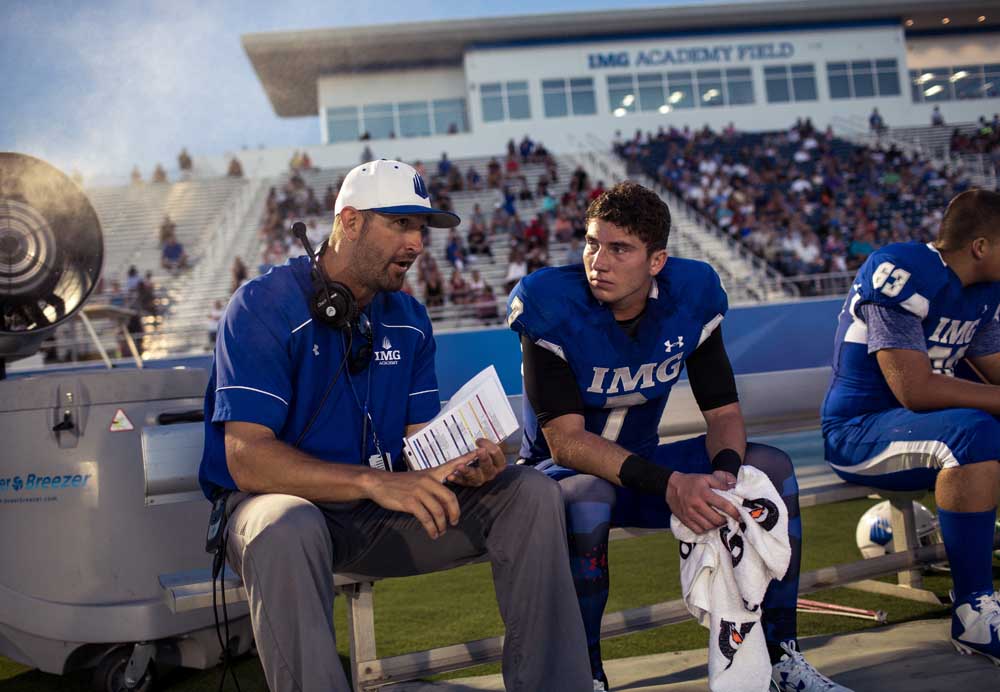At IMG Academy, preps are profitable
Published 12:00 am Sunday, September 20, 2015

- IMG Academy offensive coordinator Rich Bartel, left, talks with quarterback Shea Patterson during a football game in Bradenton, Florida. Edward Linsmier / The New York Times
BRADENTON, Fla. — The sun had not yet set last Friday on a field ringed by palm trees when, on the first play from scrimmage, Shea Patterson rolled to his left and threw a 69-yard touchdown pass for his high school, IMG Academy, a private, for-profit sports boarding school.
On the academy’s campus, the latest experiment in prep football is taking root and could produce, depending on one’s view, bountiful harvests of talent or a blight of professionalism. Coaches and officials around the country are watching with curiosity and wariness.
Patterson, who is considered the nation’s top high school quarterback, threw the scoring pass to receiver Drake Davis, a national indoor sprint champion. By halftime, Patterson had thrown four touchdown passes, including one to Isaac Nauta, who is rated as the country’s No. 1 tight end prospect.
IMG Academy throttled Cocoa High School, a public school, 49-7.
“We’re the best team in the country,” said Patterson, 18, a senior who is 6 feet 2 inches and 192 pounds, and has thrown 104 career touchdown passes with eight interceptions at three high schools.
Nauta, 18, who is 6-4 and 237 pounds, said: “Every day in practice is just a grind against our own guys. That’s probably the best competition we’re going to face all year.”
Their assuredness is as bold as the company behind the school: IMG, the global sports management conglomerate that has helped propel the competitive leap that high school football has made. Increasingly, prep football talent is being consolidated on powerful public, private, parochial, charter and magnet school teams. And recruiting to those schools is widespread in one guise or another.
IMG is at the forefront. It is trying to enhance its academy brand with football, perhaps the most visible sport. And it is applying a business model to the gridiron that has long been profitable for tennis and has expanded to golf, soccer, baseball, basketball, lacrosse and track and field. The academy has nearly 1,000 students from more than 80 countries enrolled in prekindergarten through 12th grade and postgraduation. About half the students are international.
The school, 45 miles south of Tampa, recruits football players from around the country, offering high-performance training, college preparatory courses, coaches with NFL playing experience, facilities that resemble a small college more than a high school, and a chance to play on national television.
Though IMG Academy has fielded a varsity football team for only three seasons and, as an independent school, is ineligible to play for a Florida state championship, it is stocked with six of the nation’s top 100 senior recruits. The roster has players from 21 states and six countries.
The full cost of tuition and boarding for a year of football at IMG Academy is $70,800, although need-based financial assistance is available. School officials would not provide specific figures, but they said that payments by families could range from tens of thousands of dollars to a competition fee (between $3,750 and $4,500) to nothing.
Team helmets are adorned with IMG’s corporate logo. The cheerleaders and the pep band are themselves all-star performers from the area. Even the team nickname, the Ascenders, suggests players are there with college in mind as much as high school.
The academy was founded in 1978 by Nick Bollettieri as a tennis boarding school. Andre Agassi, Serena Williams and Maria Sharapova have trained there. IMG bought the academy in 1987, and it now covers more than 500 acres.
Football began in 2013 as part of a $197 million campus expansion. Games are played in a 5,000-seat stadium outfitted with suites and a jumbo video screen. Some NFL players train there in the offseason, as do college players preparing for the NFL draft.
IMG officials are upfront about their profit motive. And they have been backed financially by state lawmakers who justify the assistance by citing the academy’s economic impact to the region in training more than 12,000 athletes yearly from the youth level to the pros and in hosting numerous amateur and professional sports competitions. Although it is private, IMG Academy has received more than $7 million from the Florida state budget over the past two years, according to news accounts.
“We run a business,” said Chip McCarthy, a co-managing director of IMG Academy. “We call it sales and marketing. Some people call it recruiting. We’re promoting our program. If you look at any private school that emphasizes sports, they’re typically doing it to promote their school.”
Officials at IMG also freely say the academy is not for everyone. Several highly regarded players have left, citing homesickness, a philosophical clash with coaches or a feeling of being overwhelmed by the commitment.
Many high school football coaches and officials are closely following IMG Academy, wondering whether it portends the growth of similar academies or superleagues featuring top teams.
Some Florida schools refuse to play IMG Academy. Some coaches from other states are upset that IMG has poached players whom they developed. And there are accusations — vehemently rebutted by IMG — that it is merely a football factory where “student” is a neglected companion in the phrase student-athlete.
Mickey McCarty, who has coached three state championship teams at Neville High School in Monroe, Louisiana, and who lost a senior receiver to IMG Academy days before fall practice began, said the academy seemed less a traditional football team than a showcase for individual talent.
“It sounds to me like they’re playing for self, to be promoted and recruited, which takes away everything we stand for,” McCarty said.
Academy officials said that 186 athletes from IMG’s 2015 graduating class were playing various college sports, including six at Ivy League universities and four at service academies. Academics and athletics are intended to simulate the college experience with dormitory living, alternate-day classes, block scheduling and a focus on time management.
“It is the best preparation for a high school kid to get to the next level quick,” said Kevin Wright, IMG Academy’s first-year head coach.
Football players said there was a curfew at 10:30 p.m.
“I came here assuming it was going to be easy, it’s just going to be a football school, but I learned within the first week I was completely wrong,” said Kjetil Cline, 17, a senior receiver from Minnesota who plans to play football at Army. “That really opened my eyes about what college would be like, and I think it’s really prepared me for going to West Point.”
The National Federation of State High School Associations has not taken an official position on IMG Academy, said Bob Gardner, the association’s executive director. But he added: “We think the high school experience is best served by the student-athlete who lives at home with his family and is part of his school, family and community.”
The players at IMG and their families consider that approach to be antiquated. For Patterson, a quarterback who won state championships the previous two seasons at a high school in Louisiana, IMG Academy is serving as a finishing school.
Patterson said he transferred to IMG in June to work on his speed, strength and conditioning. He plans to graduate in December, enroll for the spring semester at the University of Mississippi and challenge for the starting quarterback position there next fall as a freshman.
“It’s definitely a professional decision,” he said.








